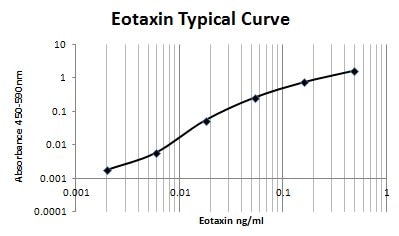Human CCL11/Eotaxin Biotinylated Antibody Summary
Gly24-Pro97
Accession # Q6I9T4
Applications
Human CCL11/Eotaxin Sandwich Immunoassay
Please Note: Optimal dilutions should be determined by each laboratory for each application. General Protocols are available in the Technical Information section on our website.
Reconstitution Calculator
Preparation and Storage
- 12 months from date of receipt, -20 to -70 °C as supplied.
- 1 month, 2 to 8 °C under sterile conditions after reconstitution.
- 6 months, -20 to -70 °C under sterile conditions after reconstitution.
Background: CCL11/Eotaxin
CCL11 is a potent eosinophil chemoattractant that was originally purified from bronchoalveolar lavage fluid of guinea pigs sensitized by aerosol challenge with ovalbumin. Microsequencing of the purified protein revealed the guinea pig CCL11 to be a member of the beta (CC) chemokine family of inflammatory and immunoregulatory cytokines. cDNA clones for guinea pig, mouse and human CCL11 have been isolated. Human CCL11 cDNA encodes a 97 amino acid residue precursor protein from which the amino-terminal 23 amino acid residues are cleaved to generate the 74 amino acid residue mature human CCL11. At the protein sequence level, mature human CCL11 is approximately 60% identical to mature mouse and guinea pig CCL11. In addition, human CCL11 also shows high amino acid sequence identity to human MCP-1, 2 and 3. Human CCL11 is chemotactic for eosinophils, but not mononuclear cells or neutrophils. The CC chemokine receptor 3 (CCR3) has now been identified to be a specific human CCL11 receptor (1 - 3). CCR3 has also been shown to serve as a cofactor for a restricted subset of primary HIV viruses and binding of CCL11 to CCR3 inhibited infection by the HIV isolates (4).
- Kitamura, M. et al. (1996) J. Biol. Chem 271:7725.
- Garcia-Zepeda, E.A. et al. (1996) Nature Medicine 2:449.
- Ponath, P.D. et al. (1996) J. Clin. Invest. 97:604.
- Choe, H. et al. (1996) Cell 85:1135.
Product Datasheets
Citations for Human CCL11/Eotaxin Biotinylated Antibody
R&D Systems personnel manually curate a database that contains references using R&D Systems products. The data collected includes not only links to publications in PubMed, but also provides information about sample types, species, and experimental conditions.
8
Citations: Showing 1 - 8
Filter your results:
Filter by:
-
The Global Phosphorylation Landscape of SARS-CoV-2 Infection
Authors: Mehdi Bouhaddou, Danish Memon, Bjoern Meyer, Kris M. White, Veronica V. Rezelj, Miguel Correa Marrero et al.
Cell
-
Placental immune response to apple allergen in allergic mothers
Authors: Martina Sandberg Abelius, Uta Enke, Frauke Varosi, Heike Hoyer, Ekkehard Schleussner, Maria C. Jenmalm et al.
Journal of Reproductive Immunology
-
A Th1/Th2-associated chemokine imbalance during infancy in children developing eczema, wheeze and sensitization
Authors: T. R. Abrahamsson, M. Sandberg Abelius, A. Forsberg, B. Björkstén, M. C. Jenmalm
Clinical & Experimental Allergy
-
Th1 and Th2 Chemokines, Vaccine-Induced Immunity, and Allergic Disease in Infants After Maternal omega -3 Fatty Acid Supplementation During Pregnancy and Lactation
Authors: Catrin Furuhjelm, Maria C Jenmalm, Karin Fälth-Magnusson, Karel Duchén
Pediatric Research
-
Maternal and cord plasma cytokine and chemokine profile in pregnancies complicated by asthma.
Authors: Osei-Kumah A, Smith R, Clifton VL
Cytokine, 2008-07-17;43(2):187-93.
Species: Human
Sample Types: Plasma
Applications: ELISA Development -
Increased expression of Th2-associated chemokines in bullous pemphigoid disease. Role of eosinophils in the production and release of these chemokines.
Authors: Gounni Abdelilah S, Wellemans V, Agouli M, Guenounou M, Hamid Q, Beck LA, Lamkhioued B
Clin. Immunol., 2006-06-16;120(2):220-31.
Species: Human
Sample Types: Cell Culture Supernates
Applications: ELISA Development -
Manipulation of host cytokine network by ticks: a potential gateway for pathogen transmission.
Authors: Hajnicka V, Vancova I, Kocakova P, Slovak M, Gasperik J, Slavikova M, Hails RS, Labuda M, Nuttall PA
Parasitology, 2005-03-01;130(0):333-42.
Species: Human
Sample Types: Saliva
Applications: ELISA Development -
Chemoattractant factors in breast milk from allergic and nonallergic mothers.
Authors: Bottcher MF, Jenmalm MC, Bjorksten B, Garofalo RP
Pediatr. Res., 2000-05-01;47(5):592-7.
Species: Human
Sample Types: Serum
Applications: ELISA Development
FAQs
No product specific FAQs exist for this product, however you may
View all Antibody FAQsReviews for Human CCL11/Eotaxin Biotinylated Antibody
Average Rating: 5 (Based on 1 Review)
Have you used Human CCL11/Eotaxin Biotinylated Antibody?
Submit a review and receive an Amazon gift card.
$25/€18/£15/$25CAN/¥75 Yuan/¥2500 Yen for a review with an image
$10/€7/£6/$10 CAD/¥70 Yuan/¥1110 Yen for a review without an image
Filter by:



